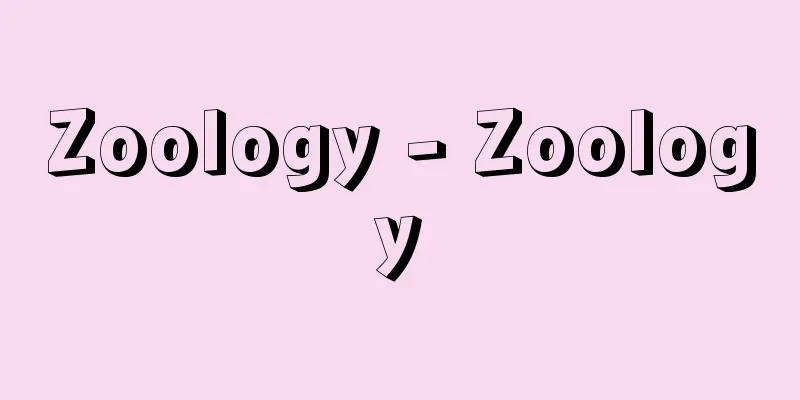Zoology - Zoology

|
The science of animals. Animals have had many connections with humans since ancient times and have been a subject of strong interest. It is not difficult to imagine from ancient murals that a great deal of knowledge has been accumulated about animals as targets for hunting and fishing, as well as wild beasts and sharks that attack humans, and harmful animals such as bees and mosquitoes. Humans also have a long history of raising and managing animals, such as livestock and beekeeping, and keeping them as pets. However, when we say zoology, we mean the intellectual system related to animals, and it can be seen as a branch of natural history along with botany and geology. [Nobuo Egami] History of ZoologyZoology as a branch of natural history began in the 4th century BC when Aristotle of ancient Greece classified many animals and wrote various descriptions of them. During the so-called Dark Ages of the Middle Ages, there were only fragmentary records of animal classification and ecology, and there was no trend to study animals from a natural science perspective, so zoology made no significant progress. After the Renaissance, people started to return to the old spirit of observing and learning from nature, and, coupled with the advancement of navigation, people had more opportunities to come into contact with animals from all over the world, which led to a broadening of interest in animals. Furthermore, there were signs that biological interest in animals was developing into a search for causality. For example, British physiologist W. Harvey asserted that blood in the human body circulates through blood vessels and that the driving force behind this is the beating of the heart. Furthermore, the invention of the microscope revealed the existence of minute animals and revealed their cell structure, which brought about groundbreaking progress in zoology. [Nobuo Egami] Zoological scienceZoomorphology was developed by Geoffrey Saint-Hilaire and his son in France, T. H. Huxley in England, and E. H. Haeckel in Germany, and progressed to comparative anatomy of various animal forms. Zooembryology also flourished by K. E. Baer in Germany, A. O. Kovalevsky in Russia, and the Hertwig brothers in Germany, and the relationship between development and evolution became the focus of interest. The origins of the theory of animal evolution date back to the 18th century. In his book, C. Linnaeus of Sweden named animals, stating that there existed species similar to those created by God, which became the origin of scientific names. Around that time, many people began to take an interest in evolution, and in 1859, the theory of evolution was victorious with the publication of "On the Origin of Species" by C. Darwin of England. Furthermore, in the field of developmental biology, not content with simply observing normal development, a field of study was developed in which various experimental procedures were applied to developing animal embryos in order to study the mechanisms of development. This field was developed by German scientists such as Henri Driesch and Henri Spemann, and it once became the most interesting area of zoology. The main focus of zoology has been on the classification, morphology, and ecology of animals, but interest has gradually expanded to include physiology and biochemistry, and there has been a tendency to shift the focus from an individual-centered perspective to cells. Along with the remarkable progress in biology in general in recent years, there has been remarkable progress in the field of analyzing the various phenomena exhibited by animals from a broader perspective using natural science. For example, when classifying animals, we are no longer limited to morphology; we are now incorporating biochemical and immunological techniques to look at the characteristics (amino acid composition) of the proteins that make up the cells of each species, and to analyze their behavior. Currently, as a branch of biology, there is a strong tendency to use molecular biology as a basis to clarify the general principles of phenomena common to all animals. However, the study of characteristics of each group of animals and comparative research are also important parts of zoology, and for convenience zoology is often divided into two major categories, vertebrate zoology and invertebrate zoology, or into protozoology, entomology, and ichthyology depending on the animal group, and even more specific studies on smaller units are also popular. Among the various fields of biology, those that focus on animals may be called animal physiology, animal morphology, animal psychology, animal cytology, animal geography, animal ecology, animal genetics, animal embryology, etc., and each field has its own unique history and ideas that have progressed. [Nobuo Egami] Source: Shogakukan Encyclopedia Nipponica About Encyclopedia Nipponica Information | Legend |
|
動物に関する科学。動物は古くから人類とは多くのかかわり合いをもち、強い関心のある対象であった。狩猟や漁獲の対象としての動物や、人間を襲う野獣やサメとか、ハチやカのような有害動物に関していろいろな知識が蓄積されていたことは、古い時代の壁画などからも想像にかたくない。また、家畜や養蜂(ようほう)のように人間が動物を飼育管理したり、ペットとして愛玩(あいがん)することも古い歴史をもっている。しかし、動物学という場合には、動物に関する知的な体系を意味し、植物学や地学とともに博物学の一分科とみることもできる。 [江上信雄] 動物学の歴史博物学の一分科としての動物学は、紀元前4世紀に古代ギリシアのアリストテレスが、多くの動物を分類していろいろな記述をしたのが第一歩であった。中世のいわゆる暗黒時代には、動物の分類や生態についての断片的な記録があったにすぎず、動物について自然科学的に研究するという風潮がなく、動物学のみるべき進歩はなかった。ルネサンス以降、ふたたび自然を観察し自然から学ぶという古い時代の精神に帰る姿勢が生じ、また航海術の進歩とも絡んで、世界各地の動物に接する機会も増えて、動物に関する興味が広がった。さらに動物に対する生物学的関心が、因果律を求める方向へと発展する徴候が現れた。たとえば、イギリスの生理学者W・ハーベーが、人体の血液は血管中を循環すること、その原動力が心臓の拍動にあることを主張したのはその現れである。また、顕微鏡の発明によって微小な動物の存在が明らかになり、細胞構造がわかったことは、動物学に画期的な進展をもたらした。 [江上信雄] 動物学の諸分野動物形態学は、フランスのジョフロア・サンチレール父子、イギリスのT・H・ハクスリー、ドイツのE・H・ヘッケルらによって進められ、いろいろの動物の形態の比較解剖学へと進んだ。また動物発生学が、ドイツのK・E・ベーア、ロシアのA・O・コバレフスキー、ドイツのヘルトウィヒ兄弟らによって隆盛となり、発生と進化との関係が興味の中心となった。 動物進化論の起源は18世紀にさかのぼる。スウェーデンのC・リンネはその著のなかで、神が創造したと同様の種が存在するとして動物を命名し、これが学名の発祥となっている。そのころから進化について多くの人々が関心をもち始め、1859年に至ってイギリスのC・ダーウィンの『種の起原』によって進化論が勝利を得た。 発生学の分野ではさらに、単なる正常な発生の観察に飽き足らず、発生中の動物胚(はい)にいろいろな実験的手段を加え、これから発生の仕組みを研究する学問が、ドイツのH・ドリーシュやH・シュペーマンらによって進められ、動物学のなかでももっとも興味ある分野として一時期を風靡(ふうび)した。 動物学の主流は動物の分類や形態や生態に関するものであったが、しだいに生理学や生化学にも関心が広がり、また、個体を中心とする観点から細胞に主眼が移る傾向が生じてきた。最近における生物学全般の目覚ましい進展に伴い、動物の示すさまざまな現象も、より広い立場から自然科学的に解析する分野の進歩が著しい。たとえば動物の分類にしても、形態にとどまらず、生化学や免疫学的な手法などを取り入れて、その種の細胞を構成するタンパク質の特性(アミノ酸組成)をみるとか、行動を解析するといった手段もとられるようになってきた。そして現在では、生物学の一分野として、分子生物学にも基盤を置いて動物に共通した諸現象の一般原理を明らかにしようという傾向が強くなっている。 しかしまた、動物の各群に特徴的な点の研究ないし比較研究も動物学の重要な部分であり、便宜的に動物学を脊椎動物学(せきついどうぶつがく)と無脊椎動物学に二大別したり、動物群によって、原生動物学、昆虫学、魚類学に分けたり、さらにはもっと細かい単位での各論も盛んである。 生物学のいろいろな分野のうち動物を主体として扱う場合には、動物生理学、動物形態学、動物心理学、動物細胞学、動物地理学、動物生態学、動物遺伝学、動物発生学などというようによぶこともあり、それぞれの分野は独特の歴史、発想をもって進歩している。 [江上信雄] 出典 小学館 日本大百科全書(ニッポニカ)日本大百科全書(ニッポニカ)について 情報 | 凡例 |
Recommend
Father of English Poetry
…the greatest poet of medieval England. The found...
Court manuscripts - Court manuscripts
…Art flourished in the Frankish Kingdom, ruled by...
Guilelmus Durantis
1232 to 37‐96 French canon law scholar. His French...
Amyotrophic lateral sclerosis
(1) Amyotrophic lateral sclerosis (ALS) Definition...
Yomiuri Shimbun - Yomiuri Shimbun
It is one of Japan's leading national newspap...
Maruseppu [town] - Maruseppu
A former town in Monbetsu District, Hokkaido. The ...
Abnek, FA - Abnek
…Op. 14a. Composed in 1830, it was premiered on D...
Lakōnikē (English spelling)
…Laconia is a region in southern Greece and the s...
Outer rim of a crater - Gairinzan
When a new volcano forms in a large depression in...
āgama (English spelling) agama
...An early Buddhist scripture that compiles the ...
Karem, MA - Karem
… During the Imperial period and the Restoration ...
Ulm Cathedral - Ulmer Münster
Ulm Cathedral in the state of Baden-Württemberg in...
Raeburn, H.
...The Swiss J.H. Füssli, who was a close friend ...
Behemoth; The Structure and Practice of National Socialism
This is the major work of American political scien...
Anti-Corn Law League
An organization formed in Manchester on March 20,...









